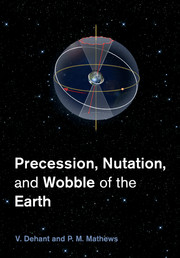Book contents
- Frontmatter
- Contents
- Preface
- List of abbreviations
- 1 Introduction – Fundamental definitions – Motivation
- 2 Concepts and elementary theory
- 3 Reference systems and frames
- 4 Observational techniques – ephemerides
- 5 Rigid Earth precession and nutation
- 6 Deformable Earth – Love numbers
- 7 Nutations of a non-rigid Earth
- 8 Anelasticity
- 9 Ocean and atmospheric corrections
- 10 Refinements of non-rigid nutation
- 11 Comparison observation-theory
- 12 Conventions
- 13 Mars nutations
- Appendix A Rotation representation
- Appendix B Clairaut theory
- Appendix C Definitions of equinoxes
- Bibliography
- Index
5 - Rigid Earth precession and nutation
Published online by Cambridge University Press: 05 May 2015
- Frontmatter
- Contents
- Preface
- List of abbreviations
- 1 Introduction – Fundamental definitions – Motivation
- 2 Concepts and elementary theory
- 3 Reference systems and frames
- 4 Observational techniques – ephemerides
- 5 Rigid Earth precession and nutation
- 6 Deformable Earth – Love numbers
- 7 Nutations of a non-rigid Earth
- 8 Anelasticity
- 9 Ocean and atmospheric corrections
- 10 Refinements of non-rigid nutation
- 11 Comparison observation-theory
- 12 Conventions
- 13 Mars nutations
- Appendix A Rotation representation
- Appendix B Clairaut theory
- Appendix C Definitions of equinoxes
- Bibliography
- Index
Summary
In the forcing of Earth rotation variations by gravitational action of the solar system bodies, the moments of the matter distribution inside the Earth, which go by the name “geopotential coefficients,” play a direct role. The geopotential coefficients of degree two, which are proportional to the elements of the inertia tensor, are by far the most important of these; but coefficients of all higher orders too have their roles. One needs to use the spherical harmonics (or more formally, the surface spherical harmonic functions) for defining the geopotential coefficients. These functions and their properties (to the extent that they are essential for our purposes) are presented in Section 5.3.5, before we go on to construction of the geopotential coefficients.
All the geopotential coefficients remain invariant in time for a rigid Earth which cannot, by definition, deform. The potential energy of the Earth's gravitational interaction with a celestial body is expressible in terms of these coefficients and the time dependent position of that body in relation to an Earth-fixed reference frame. The determination of the rotation variations should then, in principle, be a simple matter, if the values of these coefficients and the time dependence of the positions of the Moon, Sun, and planets relative to the Earth are known. It is generally understood that the values to be used for the geopotential coefficients of the “rigid Earth” are to be the same as for the actual Earth in its undeformed uniformly rotating state, not subject to any perturbations. These values are determined from satellite laser ranging (SLR) or GNSS observations of the orbital motions of dedicated artificial Earth satellites such as LAGEOS, CHAMP, GRACE, GOCE… (see Section 1.6 of Chapter 1), after separating out the contributions from time dependent perturbations.
The orbits of the Moon around the Earth and of the Earth and other planets around the Sun are Keplerian ellipses (see Section 4.4) when these bodies are idealized as point masses and each body is viewed as being subject to the gravitational influence of just one other body (the Sun, in the case of the Earth and other planets, and the Earth in the case of the Moon).
- Type
- Chapter
- Information
- Precession, Nutation and Wobble of the Earth , pp. 121 - 209Publisher: Cambridge University PressPrint publication year: 2015
- 2
- Cited by



